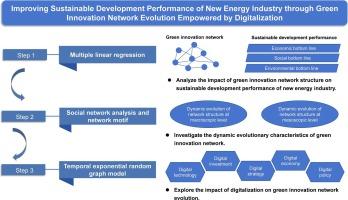通过数字化赋能的绿色创新网络演进提升新能源产业可持续发展绩效基于时间指数随机图模型
IF 9.9
1区 工程技术
Q1 ENERGY & FUELS
引用次数: 0
摘要
新能源产业的可持续发展对于应对气候变化和各种挑战至关重要,这需要数字化所带来的绿色创新网络的支持。然而,数字化的各个维度在推动网络发展以提高可持续发展绩效方面的影响还有待充分探讨。因此,本研究旨在探讨多维度数字化如何为绿色创新网络提供动力,并确定数字化的关键要素,从而有效提高可持续发展绩效。本研究利用绿色专利构建了中国新能源企业的绿色创新网络。首先,通过多元回归分析,从结构嵌入性的角度分析了网络结构对可持续发展绩效的影响。然后,通过社会网络分析和网络动机研究了网络结构在宏观和中观层面的动态演化特征。然后,建立了多维数字化框架,并结合五类数字化要素,运用时间指数随机图模型揭示了绿色创新网络的演化机制。研究结果表明(1)绿色创新网络结构影响可持续发展绩效,高亲近中心度和间度中心度的企业表现出更优越的可持续发展绩效。(2)绿色创新网络的演化特征表明网络缺乏弹性,需要通过促进创新协作关系的形成来优化网络结构。(3)多维数字化要素对绿色创新网络的影响具有异质性和动态性。数字技术、数字投资、数字战略和数字政策有利于网络的良性发展,促进网络的形成,而数字经济则会产生负面影响。企业间相似的数字化战略有利于绿色创新网络的形成。本研究为地方政府制定产业政策和新能源企业优化数字化要素、提高可持续发展绩效提供了有价值的启示。本文章由计算机程序翻译,如有差异,请以英文原文为准。

Improving sustainable development performance of new energy industry through green innovation network evolution empowered by digitalization: Based on temporal exponential random graph model
The sustainable development of the new energy industry is crucial for addressing climate change and facing various challenges, which requires the support of green innovation network effected by digitalization. Nonetheless, the influence of each dimension of digitalization in driving network development to enhance sustainable development performance has yet to be adequately explored. Therefore, this study aims to explore how multi-dimensional digitization dynamically empowers green innovation networks and identifies key digitalization elements, thus effectively improving sustainable development performance. Green innovation networks of new energy enterprises in China are constructed using green patents. First, the impact of network structure on sustainable development performance is analyzed from the perspective of structural embeddedness with multiple regression analysis. Further, the dynamic evolutionary characteristics of network structure at macroscopic and mesoscopic levels are investigated through social network analysis and network motif. Then, a multi-dimensional digitalization framework is established, and the temporal exponential random graph model is employed to uncover the evolutionary mechanism of green innovation network, considering five types of digitalization elements. The findings indicate the following: (1) Green innovation network structure affects sustainable development performance and enterprises with high closeness centrality and betweenness centrality exhibit superior sustainable development performance. (2) The evolutionary characteristics of green innovation networks reveal the networks lacks resilience, necessitating the optimization of network structure through promoting formation of innovation collaboration relationships. (3) The impacts of multi-dimensional digitalization elements on green innovation network are heterogeneous and dynamic. Digital technology, digital investment, digital strategy, and digital policy empower the positive development of networks and facilitate network formation, while digital economy exerts a negative effect. Similar digital strategies among enterprises facilitate the formation of green innovation networks. This study offers valuable insights for local governments in formulating industrial policies and for new energy enterprises in optimizing digitalization elements and improving sustainable development performance.
求助全文
通过发布文献求助,成功后即可免费获取论文全文。
去求助
来源期刊

Energy Conversion and Management
工程技术-力学
CiteScore
19.00
自引率
11.50%
发文量
1304
审稿时长
17 days
期刊介绍:
The journal Energy Conversion and Management provides a forum for publishing original contributions and comprehensive technical review articles of interdisciplinary and original research on all important energy topics.
The topics considered include energy generation, utilization, conversion, storage, transmission, conservation, management and sustainability. These topics typically involve various types of energy such as mechanical, thermal, nuclear, chemical, electromagnetic, magnetic and electric. These energy types cover all known energy resources, including renewable resources (e.g., solar, bio, hydro, wind, geothermal and ocean energy), fossil fuels and nuclear resources.
 求助内容:
求助内容: 应助结果提醒方式:
应助结果提醒方式:


